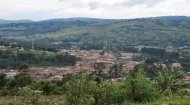
|
Lake Bunyonyi Guide |
Lake Bunyonyi Guide |
Lake Bunyonyi Guide | Lake Bunyonyi Guide |
|
|

|
This influx of visitors is drawn by a host of attractions that go beyond simply admiring the view. Canoe trips in traditional dugout canoes (below, left) or faster motorboat tours are the primary way to explore the islands, each journey offering a new perspective of the coves and inlets. Hiking the surrounding hills rewards the energetic with unparalleled panoramic vistas of the lake and the distant Virunga volcanoes. For the truly adventurous, it’s possible to combine a visit with gorilla trekking in nearby Bwindi Impenetrable National Park, making for an unforgettable itinerary of both highland and aquatic wonder. Community-based tourism is also thriving, with opportunities to visit local villages, learn about pottery with the Batwa people, the original forest inhabitants, or simply share a conversation with a farmer tending his fields. Aware of its fragile beauty, conservation efforts are quietly underway to protect Lake Bunyonyi’s ecosystem. The main challenges include preventing soil erosion from the steep hillsides, managing water quality, and dealing with the invasive water hyacinth plant. Several local organisations and lodges are actively involved in tree-planting initiatives to stabilise the banks and preserve the watershed. The conscious shift towards eco-friendly tourism practices, including proper waste management and the use of solar power by many accommodations, helps to minimise the human footprint on this pristine environment. The goal is a sustainable balance where tourism supports the community without compromising the natural resources that make the lake so special, exemplified by Eco Island. When the sun begins to set, casting a golden glow over the water and turning the sky into a canvas of oranges and purples (see our banner image above), the choice of accommodation becomes part of the experience. The lakeshore offers a wide spectrum, from basic backpacker hostels and campsites to luxurious eco-lodges perched on stilts over the water. Waking up in a cottage with a private veranda, listening to the birds and watching dugout canoes silently slice through the morning mist, is an experience that lingers long after you depart. Whether you seek rustic simplicity or indulgent comfort, there is a place to stay that allows you to fully immerse yourself in the lake’s tranquil rhythm. Probably the best time to visit is during the dry season, which runs from June to August and December to February. If you know of other tourist attractions in the area, please get in touch and let us know using our contact form to we can update this Lake Bunyonyi travel guide. |








